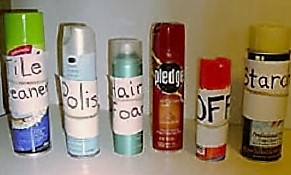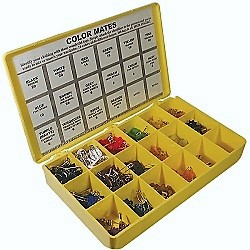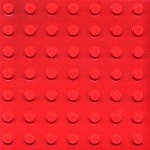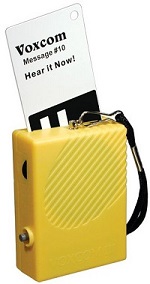Labeling and Marking
Labeling Considerations
In many cases, good household and kitchen organization can reduce the need for extensive labeling and marking. For more information about organization and labeling, see Household Organization, Home Modifications, and Organizing and Labeling Clothing on the VisionAware website. If you still want or need to label household items (such as food, clothing, and medication) after trying our household organization and home modification tips, here are some questions to ask yourself before you begin to label items in your home:- Should the labeling system be permanent?
- Can the labels be reused?
- Does the labeling material have to be durable and withstand laundering and/or daily use?
- How will the label be attached to an item?
- Will the placement of the label interfere with the use of an item?
- Hint: Prepare labels in advance based on your shopping list. Label cans the same day they arrive from the store, before you put them away.
Using Everyday Products for Labeling
There are a number of labeling systems that you can implement with regular household or office supply materials or specialty labeling products. If you have low vision, try using any of the following household or office supply materials:- White or fluorescent unruled 3″x 5″ index cards
- Jumbo colored paper clips
- Colored adhesive labels
- Colored Dymo labeling tape
- Colored electrical or plastic tape
- Wide-tip markers
- Flair felt-tip pens
- 20/20 felt-tip pens
- Laundry markers
- Polymark fabric/craft paint
- Safety pins
- Rubber bands
- Pipe cleaners
- Velcro
- Self-stick magnetic tape
- Velour pads/furniture protectors
- Iron-on patches
- Foam alphabet letters
- Polymark fabric/craft paint
Identifying and Labeling Household Items
You can label and identify household and kitchen items by using any of the following methods:- Place a rubber band around a can of corn to distinguish it from a can of green beans.
- Use a black wide-tip marker, a laundry marker, or a felt-tip pen to write in large, bold letters on plain white 3×5″ index cards. Use these labels to differentiate household supplies that are stored in similar spray containers, such as window cleaners, bathroom cleaners, and all-purpose cleaners. Attach each card to the appropriate container with a rubber band, as illustrated below:

- Use brightly colored electrical or plastic tape, pipe cleaners, Velcro, fabric or craft paint, or velour pads/furniture protectors to place markers on canned goods.
- Create tactile labels for bolts, nails, or paper clips in individual containers by gluing one of each item to the outside of the container.
- Place a different number of rubber bands around each different container.
- Transfer items to different shaped containers.
- Tie different-textured ribbons around the neck or opening of each container.
Identifying Kitchen Items
There are many different methods for organizing and identifying items in your kitchen:- By weight: A container of breadcrumbs and a container of powdered drink mix have the same size and shape, but are easily differentiated by weight.
- By location or placement: Try any of the following methods: grouping similar items together, such as fruits, soups, or vegetables; placing frequently-used items toward the front of shelves and cabinets; storing foods or supplies in alphabetical order.
- By sound: Use auditory cues to differentiate items that have the same size, shape, and weight. For example, a can of fruit cocktail sounds very different from a can of tomato paste when shaken.
- By size and shape: A can of tomato paste differs in size and shape from a can of stewed tomatoes.
Use Specialty Labeling Products
There are also many specialty labeling products for people who are blind or have low vision.- Braille Clothing Identifiers: Durable and washable white plastic tags with braille and corresponding black print. They can be sewn or pinned on to the garment. Each label contains just 2-3 braille letters that you can learn to recognize by touch without having to learn to read the entire braille system:

- Color Mates Clothing Identifiers: Package of 160 tags, 16 colors in different shapes on safety pins to identify, mix, and match wardrobe items:

- Identi-Buttons Clothing Identifiers: Package of eight buttons, one button per color, all in different shapes:

- Hi-Mark Tactile Pen: A three-dimensional plastic liquid that makes raised lines, dots, and shapes to identify clothing, canned goods, frozen foods, and mark the settings on appliances:

- Spot ‘n Line Pen: A three-dimensional plastic liquid that makes raised lines, dots and shapes to identify clothing, canned goods, frozen foods, and mark the settings on appliances:

- Loc-Dots: Clear raised dots to mark index cards, appliances, computers, and keyboards. They cannot be used directly on the clothing item.
- Maxi-Marks: Black plastic dots and slashes with adhesive backing to mark index cards, appliances, computers, and keyboards. They cannot be used directly on the clothing item.
- Touch Dots: Black, white, red, yellow, and orange raised foam dots with adhesive backing to mark index cards, appliances, computers and keyboards. They cannot be used directly on the clothing item:

- Bump Dots: Black, orange, and clear raised plastic dots with adhesive backing to mark index cards, appliances, computers and keyboards. They cannot be used directly on the clothing item:

- Touch-To-See Labels: Braille and tactile adhesive labels to mark index cards, medication, and food. Each reusable label contains a raised letter or number with corresponding braille. They cannot be used directly on the clothing item:

- Pen Friend 2: An electronic color identifier and voice labeling system that allows users to record, and re-record, information on to self-adhesive labels. The device will speak the color aloud when you hold it against the garment:

- Talking Color Identifier with Light Probe: This electronic device detects approximately 100 colors. The device will speak the color aloud when you hold it against the garment:

- VOXCOM III Voice Labeling System: Record audio talk labels and messages by depressing a button and inserting a card into the unit. The card attaches to canned goods, medication, clothing, food, and household items:
